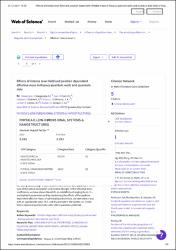| dc.contributor.author | Kasapoğlu, Esin | |
| dc.date.accessioned | 2022-04-29T08:03:26Z | |
| dc.date.available | 2022-04-29T08:03:26Z | |
| dc.date.issued | 2021 | tr |
| dc.identifier.uri | https://hdl.handle.net/20.500.12418/12614 | |
| dc.description.abstract | Using the effective mass and parabolic band approximations, we investigated the position-dependent effective mass and non-resonant intense laser field effects on the first and third-order corrections of the absorption and relative changes of the refraction index coefficients for intersubband transition in Razavy-like quantum wells. Calculations have been extended to the spherical Razavy-like quantum dots electronic structure. We have shown that depending on the combinations of the Razavy-like potential parameters, the quantum wells can evolve from parabolic confinement in an isolated quantum well to a configuration of two coupled quantum wells. We have shown that in general the transition energies (dipole matrix elements) between the ground state and the first excited state: i) are decreasing (increasing) functions of M-parameter, ii) are increasing (decreasing) functions of A-parameter, iii) they increase (decrease) when considering the position-dependent effective mass effects, and iv) are increasing (decreasing) functions of the intense laser field parameter. In the case of the optical absorption and relative changes in the refractive index coefficients, we have shown blueshifts or redshifts by changing the A-, M-,
and α0-parameters and by considering the effects of the position-dependent effective mass. In spherical quantum dots, we have shown that with an appropriate value of A- and M-parameters the system can evolve from a spherical quantum dot with infinite parabolic potential. | tr |
| dc.language.iso | eng | tr |
| dc.relation.isversionof | 10.1016/j.physe.2020.114461 | tr |
| dc.rights | info:eu-repo/semantics/closedAccess | tr |
| dc.subject | Position dependent effective mass Razavy quantum well Razavy quantum dot Intense laser field | tr |
| dc.title | Effects of intense laser field and position dependent effective mass in Razavy quantum wells and quantum dots | tr |
| dc.type | article | tr |
| dc.contributor.department | Fen Fakültesi | tr |
| dc.contributor.authorID | 0000-0002-0893-9210 | tr |
| dc.identifier.volume | 126 | tr |
| dc.identifier.startpage | 114461 | tr |
| dc.relation.publicationcategory | Uluslararası Editör Denetimli Dergide Makale | tr |















